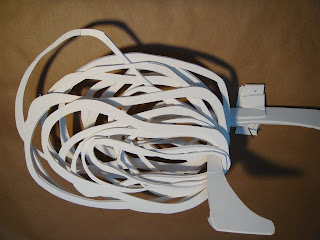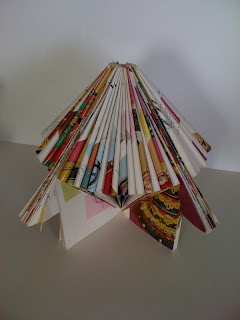AT 104: Basic Design II
Spring 2011
Project 2 : Serial Planes Studies
Phase B: Foam core 3D constructions
Recognition of a Problem:
The purpose of this project is to apply serial planes concepts
and the principles and elements of design to the creation of a
white foam board - 3D form using additive and subtractive methods.
The purpose of this project is to apply serial planes concepts
and the principles and elements of design to the creation of a
white foam board - 3D form using additive and subtractive methods.
Definition of the Problem:
Create a three-dimensional abstract or representational form that is a minimum of 12”x12”x12” using white foam core board.
The form can be free standing, hanging or mounted on a base (the design of the base/way in which the work would be installed should enhance the created form).
Incorporate repetition and gradation of size and/or shape.
You must include in some area of your design an opening to reveal the interior space construction, and in this way, explore the positive and negative space possibilities within your design.
While thinking/ sketching your design, keep in mind that the edges of the foam core will create lines, the layering of the planes will create a volume with positive and negative space, and natural and artificial light will
create gradation and shadows.
Research and Preparation
Research three-dimensional art forms and objects that use the concept of serial planes or similar construction with different materials. You may use the internet, books from the library, magazines, newspapers or your own photographs to research imagery.
Be sure to search your own natural and artificial surroundings as well.
We inhabit an everyday environment with hundreds of object/ 3d forms.
You must collect at least 10 good research images as reference before beginning sketching/constructing your project.
These images should be included in your blog as part of the research process
Gather together all the supplies you will need to begin the projects in class. Remember to use the cutting mats for easier cuts and better results while cutting foam boards. Have always available several new blades for x-acto knives.
Set up a work area at home where you can spread out your work. If you do not have adequate space at home or in your dorm, work out some schedule to use room 201 using open studio hours.
Analysis
The analysis of your project will consist of the following steps:
Altered Books – Project 2 [ Phase 1 ]. Your and your classmate’s designs, as well as issues discussed during critique, should be used as reference for the sketching/ designing the second Phase of Serial Planes project.
Sketches : Based on your book project, the research images you have collected and the images shown in class create at least 5 rough sketches. Of these sketches choose 2 or more of the most interesting designs to develop them further. Reproduce larger more detailed drawings.
Sketch models – Choose the most interesting large sketches to create sketch models. Compose your models at a scale of about 2x2x2 inches using Bristol board, card- board or foam core. Play with the forms. Build them and then pull them apart to look at other possible designs. Brainstorm!
Create a three-dimensional abstract or representational form that is a minimum of 12”x12”x12” using white foam core board.
The form can be free standing, hanging or mounted on a base (the design of the base/way in which the work would be installed should enhance the created form).
Incorporate repetition and gradation of size and/or shape.
You must include in some area of your design an opening to reveal the interior space construction, and in this way, explore the positive and negative space possibilities within your design.
While thinking/ sketching your design, keep in mind that the edges of the foam core will create lines, the layering of the planes will create a volume with positive and negative space, and natural and artificial light will
create gradation and shadows.
Research and Preparation
Research three-dimensional art forms and objects that use the concept of serial planes or similar construction with different materials. You may use the internet, books from the library, magazines, newspapers or your own photographs to research imagery.
Be sure to search your own natural and artificial surroundings as well.
We inhabit an everyday environment with hundreds of object/ 3d forms.
You must collect at least 10 good research images as reference before beginning sketching/constructing your project.
These images should be included in your blog as part of the research process
Gather together all the supplies you will need to begin the projects in class. Remember to use the cutting mats for easier cuts and better results while cutting foam boards. Have always available several new blades for x-acto knives.
Set up a work area at home where you can spread out your work. If you do not have adequate space at home or in your dorm, work out some schedule to use room 201 using open studio hours.
Analysis
The analysis of your project will consist of the following steps:
Altered Books – Project 2 [ Phase 1 ]. Your and your classmate’s designs, as well as issues discussed during critique, should be used as reference for the sketching/ designing the second Phase of Serial Planes project.
Sketches : Based on your book project, the research images you have collected and the images shown in class create at least 5 rough sketches. Of these sketches choose 2 or more of the most interesting designs to develop them further. Reproduce larger more detailed drawings.
Sketch models – Choose the most interesting large sketches to create sketch models. Compose your models at a scale of about 2x2x2 inches using Bristol board, card- board or foam core. Play with the forms. Build them and then pull them apart to look at other possible designs. Brainstorm!
Synthesis
Synthesize your sketch models into a final sketch model design by incorporating one or more parts of each design (if appropriate) into a final design.
Evaluation
Evaluate the final sketch model design based on the principles and elements of design lectures, class discussion and project requirements.
Make sure your solution meets all the project requirements, especially the minimum size of 12”x12”x12” and the opening that reveals the interior construction.
Synthesize your sketch models into a final sketch model design by incorporating one or more parts of each design (if appropriate) into a final design.
Evaluation
Evaluate the final sketch model design based on the principles and elements of design lectures, class discussion and project requirements.
Make sure your solution meets all the project requirements, especially the minimum size of 12”x12”x12” and the opening that reveals the interior construction.
Presentation
From the final sketch model construct your final design out of the foam core. Calculate the number of shapes you will need and figure out the best way to transfer them to the foam core using the maximum amount foam core (least amount of scrap).
Be sure that the instructor has reviewed your final sketch model design.
(Note: during the final construction process you may find that revisions are necessary or desirable. Be prepared to use extra foam core).
You will be given 2 pieces of white foam board plus a piece for sketching. You may purchase additional foam board if you wish to develop a larger piece.
This board may be a color other than white but no more than one additional color may be used. For example: White/black, white/red, white /blue, etc.
Use adhesives that work best for your design. Consider the importance of craftsmanship throughout the construction of your project.
You will need to change knife blades often to keep edges straight and smooth. Use sandpaper or a nail file to smooth rough edges.
Implementation
Each student will give a brief oral presentation.
You are to explain how you applied serial planes concepts and the principles and elements of design to your final design. Discuss developments in the design process that you didn’t expect, were troublesome, or unusual. Finally discuss your successes and what you have learned in the process.
Project 2: Serial Planes/ Blog requirements
Phase A: Altered Books:
Sketches (if available) & Photographic Documentation of process
Phase B: White Serial Planes Sculpture/ Object
Sketches: Drawings and 3D models & Photographic Documentation of process
Reaction Paper
In this reaction paper, you will write about your experiences in both phases of the project.
Talk about your research on “Serial Planes” structures/ sculptures/buildings,
how did you approach the projects, make reference to Maya Lin’s work, or other artists that may have inspired you, etc.
Discuss your learning outcomes in each phase of the project, compare your experiences and challenges working with different materials and reflect on the project as whole.
Critique Deadlines
Section 02: Wed. March 9th
Section 04: Thursday March 10th
Section 50: Wed. March 9th
Blog to be completed during the Spring break week
Each student will give a brief oral presentation.
You are to explain how you applied serial planes concepts and the principles and elements of design to your final design. Discuss developments in the design process that you didn’t expect, were troublesome, or unusual. Finally discuss your successes and what you have learned in the process.
Project 2: Serial Planes/ Blog requirements
Phase A: Altered Books:
Sketches (if available) & Photographic Documentation of process
Phase B: White Serial Planes Sculpture/ Object
Sketches: Drawings and 3D models & Photographic Documentation of process
Reaction Paper
In this reaction paper, you will write about your experiences in both phases of the project.
Talk about your research on “Serial Planes” structures/ sculptures/buildings,
how did you approach the projects, make reference to Maya Lin’s work, or other artists that may have inspired you, etc.
Discuss your learning outcomes in each phase of the project, compare your experiences and challenges working with different materials and reflect on the project as whole.
Critique Deadlines
Section 02: Wed. March 9th
Section 04: Thursday March 10th
Section 50: Wed. March 9th
Blog to be completed during the Spring break week





















